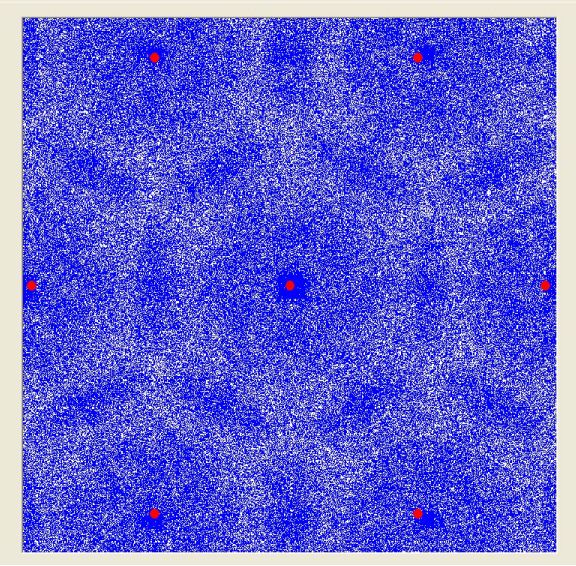I don't believe it is unsolvable at all.
First, an irrigation primer.
Although I do see things changing a bit, for the most part irrigation design is still all about achieving a uniform application of water on the SURFACE. I capitalize the word surface because I believe that is the flawed approach in modern irrigation design, but we'll get back to that.
So, we use computer tools like SpacePro software from the Center for Irrigation Technology to try and find the best possible sprinkler/nozzle/pressure combination to give us surface uniformity that looks like this on the computer screen:

(BTW, this particular densogram has heads spaced at 77', it doesn't take tight spacing to achieve uniformity)
This particular sprinkler layout has a distribution uniformity in excess of 86% in the lab. And in the real world with topography and slight pressure differences at the base of each head, if installed properly with a proper hydraulic design, it will still top out close to 80% when measured with the old catch can method.
Now, if you are trained in the art of irrigation management, then you know 80% is not 100% and so you have to turn up the run times to make up for that missing 20%. I will not spend a ton of time on this, but this IMO, is a seriously flawed approach.
Before I go into how I think irrigation should be scheduled, keep in mind that each one of those red dots represents a sprinkler that is individually controled in any modern system put in the ground in the last 10 years (at least all the ones I've seen). So every sprinkler can be individually controlled and programmed, and in many case even the arc can be individually adjusted, throw in the possible nozzle combinations and the superintendent has literally thousand of possible adjustments he can make to perfectly irrigate that area for playability.
But, what basis does he use to make those hardware adjustments and scheduling adjustments? Now we return to the word SURFACE.
We do not need water on the surface, we need water in the rootzone. And what we really need is water deep (3"-6") in the rootzone so we can grow healthy deep rooted turf instead of shallow rooted weak turf that requires nightly irrigation resulting in a boggy surface most of the time.
IMO, irrigation system audits should not be conducted on the surface with catch cans, but in the soil with soil moisture monitoring equipment. Why does this matter? Because scheduling based on soil moisture results in a dry surface and dramatically less water use. If you only apply water when the soil is ready to take water, it has somewhere to go. If you apply water based on weather factors that do not include knowing what is actually happening in the ground, you will over irrigate.
So, back to the original dilemma. If the superintendent wants to know the proper soil moisture for his soil and his turf that gives him healthy turf and a good golfing surface, then he uses a tool like this to track soil moisture and schedule his irrigation:
http://www.specmeters.com/soil-and-water/soil-moisture/fieldscout-tdr-meters/tdr300/And he tracks his soil moisture in his approaches and makes the proper adjustments. One head may run for 8 minutes, another for 11, another for....eventually he will nail the proper moisture and he will provide his golfers with a nice surface most of the time.
He'll have to combine his soil monitoring with cultural practices that keep the soil open and accepting water and he'll learn where he has no choice but to add drainage, but most importantly he'll be managing from the roots up and no super cool irrigation equipment or software will replace that knowledge. This approach is in wide use, and some of the more famous golf courses in this country are doing it, but it can still be a very hard sell. Most clients, especially public clients that have been attending irrigation seminars are very adverse to letting go of the densogram, DU, surface measurement approach to irrigation scheduling and design.
We try and make things so complicated in this business. If you don't want to be fat, don't eat to much and push your body once in a while with exercise.
If you don't want wet ground, don't add water until it is dry. I'm telling you, it isn't that hard.